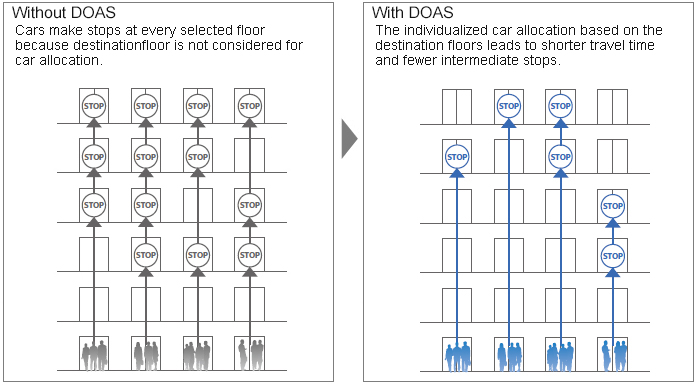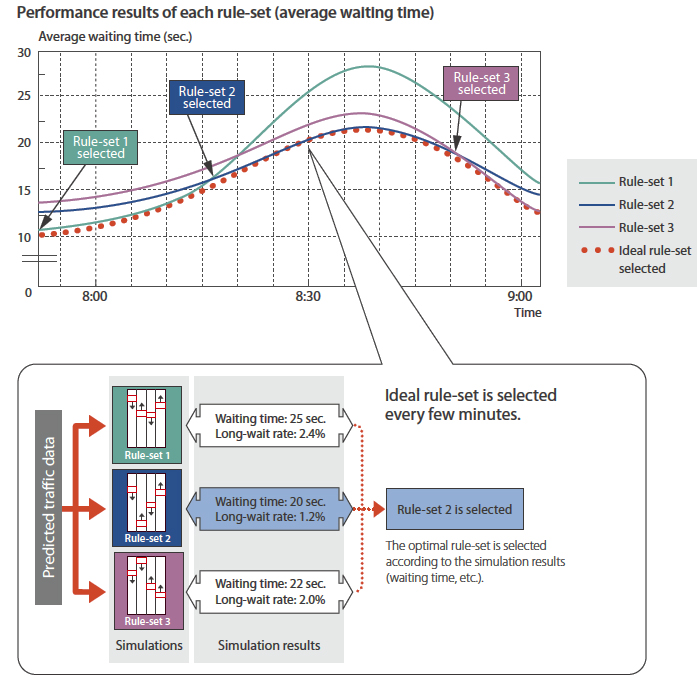Express Lifts: Faster hospital elevators
Don't want to read? Checkout this post on Youtube
In short: re-assign some elevators to travel between only two floors. Such as between Level 1 and Level 12. People can take the stairs to get to those "Express lift" levels.
This will raise people faster up the tower closer to their destination as the elevator does not stop at the floors in-between. In order for people to get to their final designation, they can walk up/down the extra stairs.
The problem: its too far to take the stairs
A vertical hospital has the benefit of a smaller footprint, and requires less distance to walk to different departments. However, considerable time is wasted waiting for elevators.
Many employees are willing to take one or two flights of stairs. Three flights is routinely double for many. However, once you get to five flights and above the number of people willing to take the stairs dramatically falls off.
In a hospital that is 16 stories high, two-thirds to three-quarters of the building is in the ‘too high to take stairs’ zone. This means, that the majority of people working in a 16 storey hospital will take the elevator multiple times a day - even if they would prefer to take some stairs.
Why elevators are slow: intermediate steps
On average at one hospital it takes a minimum of 15 seconds for the elevator doors to open and close and one person walk out. It takes about 2-3 seconds to move between floors. You do the math, if eight different floors are selected on the elevator's typical morning course that is a minimum of at least 2 minutes for the doors alone to open/close. But there are often delays getting people on/off the elevator. Estimate 3 minutes for doors. Now add a minimum of 30 seconds of elevator travel time for the building. We're at 3minutes 30 seconds, optimistically.
But, this does not include the time it takes to wait for the elevator - which is between 2-5 minutes. And the reason for the wait is that the elevators are also taking the same length of time to descend the tower as they opening/closing their doors at each floor.
From what I can tell, it is almost impossible during working hours to take the elevator from a lower level to an upper level and return back in under 11-14 minutes. (Taking the stairs is not faster, and far more sweaty). If you imagine someone working on the upper floor, perhaps they will go to the main floor several times a day. That could be upwards of over an hour per staff just in waiting for elevators. Huge productivity loss.
The Expensive Way: DOAS
The best elevator systems to remove intermediate stops have passengers request from a central kiosk their desired floor. The kiosk then tells the rider which elevator to stand in front. This allows the minimal number of intermediate steps to be calculated for passengers and the elevators available.
This system is known as Destination Floor Reservation System (DOAS) with Mitsubishi.
Or FIBIEE: Designation Floor Reservation System for Hitachi.
Image from Mitsubishi
These direct entry systems are appealing. Unfortunately, they require special hardware. Which I suspect most hospitals would be unwilling to invest in (even though I suspect a back of envelope calculation could determine the saved productivity in their staff likely would pay for the investment in a reasonable time period).
The Cheap Way: Express Lift Proposal
Although a kiosk based destination floor reservation system, would be ideal, it also requires capital to implement.
Perhaps a cheaper alternative is to assign several elevators as “Express Lifts”. Such elevators would be programmed to move between two assigned floors, or perhaps three floors.
The goal is to get most people to their destination in a hospital with a combination of one elevator ride and up to three flights or less of stairs.
As the staircase is almost always right beside the elevator bank, it is easy to start or complete the journey by stairs and use the elevator as a 'boost' through the other floors.
This system forces a function, as people learn which floors the Express Lift elevators load/unload on. This reduces variability and intermediate steps in operation, and optimized the loading/unloading process.
Timing: The express lift moves people up the building faster by eliminating intermediate steps. 15 seconds to open/close the doors at the start. 20 seconds to travel. 15 seconds to open/close at the end. Total travel time is under a minute, vs several fold that in the standard model.
Considerations
There are many ways to try and program the elevators. Ultimately they'd need fine tuning. Factors to include could be:
Current hospital usage patterns: most popular floors vs floors with less traffic.
Do people view level 1 or level 2 as the ‘main floor’ for the hospital.
Which floors have ‘dead space’ or a ‘second floor’ above them. Ideally the elevator should bypass these.
Is the transit time reduced if with two elevators going to the same floors, vs adjacent floors (e.g. two elevators going 2-8-16, or one elevator going 2-8-16 and another 1-7-15).
Example 1
A 16 story hospital. 6 main elevators.
Elevators 1 to 4: function normall
Elevator 5 - Express Lift: stops at floor 2 & 14
Elevator 6 - Express Lift: stops at floor 1 & 10
Example 2
E1: function normally, stops at each floor requested
E2: Function normally, stops at each floor requested
E3: stops at floors 2 to 9
E4: stops at floors 1 to 5, 10
E5: stops at floors 2, 8, 16
E6: stops at floors 1, 7, and 15
After Hours Schedule
Outside of daytime hours, the hospital almost always has a surplus of elevators relative to elevator call requests. In this case there is no need for an Express Lift. During the after hours, elevators should function ’normally’ stopping at the levels the passenger requests.
In addition, after hours hospital staff are more tired and less inclined to take the stairs.
Exceptions
This article does not apply to the ‘equipment’ elevators. Those dedicated to items such as stretchers and phlebotomy carts require stops at specific levels.
Destination Floor Reservation Vs Express Lift
I'd be curious how Destination Floor Reservation Systems compare to the Express Lift model for speed. In the Express Lift model users learn which floors the elevators stop on, and this creates a user behaviour that optimizes people to load and unload at those floors. Though, this presumes that users are willing to take stairs for part of their ride.
One of the downsides of the Express Lift system, is that it fails to collect real time data on the desired floors of the users. It is a static model. A well designed elevator system requires real time input so it can perform real time load balancing throughout the day based on anticipated use. Mitsubishi goes into this more:
Diagram by Mitsubishi Electric. Link to their article
FUTURE LIFT OPTIONS
I have become a big fan of high speed escalators. I think the installation of several of these between the most used floors in hospitals could be highly effective. Particularly in areas such as first and second floor, where the ceiling is particularly high given the atrium spaces and inclusion of dead-space/mechanical floors in-between.
Mitsubishi escalators shows how multiple circular elevators can be consecutively linked to create a near continuous system.
Photo by Mitsubishi Electric (link to their escalator article)
Update Nov 12 2018
Alain sends this Multi-Car Circulating elevator system by Hitachi,
Thanks to Alexander Jonsson for his engineering analysis













